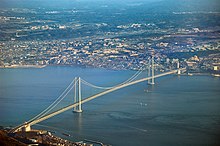Akashi Kaikyō Bridge
|
Akashi Kaikyō Bridge 明石海峡大橋 |
|
|---|---|

Akashi Kaikyō Bridge from the air
|
|
| Coordinates | 34°36′58″N 135°01′12″E / 34.616°N 135.020°ECoordinates: 34°36′58″N 135°01′12″E / 34.616°N 135.020°E |
| Carries | Six lanes of roadway and four emergency lanes |
| Crosses | Akashi Strait |
| Locale | Awaji Island and Kobe |
| Other name(s) | Pearl Bridge |
| Maintained by | Honshu-Shikoku Bridge Authority |
| Characteristics | |
| Design | Suspension bridge |
| Total length | 3,911 metres (12,831 ft; 2.430 mi) |
| Height | 282.8 metres (928 ft) (pylons) |
| Longest span | 1,991 metres (6,532 ft; 1.237 mi) |
| Clearance below | 65.72 metres (215.6 ft) |
| History | |
| Designer | Satoshi Kashima |
| Construction begin | 1988 |
| Construction end | 1998 |
| Opened | April 5, 1998 |
| Statistics | |
| Toll | ¥2,300 |
The Akashi Kaikyō Bridge (明石海峡大橋 Akashi Kaikyō Ō-hashi?) is a suspension bridge, which links the city of Kobe on the Japanese mainland of Honshu to Iwaya on Awaji Island. It crosses the busy Akashi Strait (Akashi Kaikyō in Japanese) as part of the Honshu-Shikoku Highway. It was completed in 1998, and has the longest central span of any suspension bridge in the world, at 1,991 metres (6,532 ft; 1.237 mi). It is one of the key links of the Honshū-Shikoku Bridge Project, which created three routes across the Inland Sea.
Before the Akashi Kaikyō Bridge was built, ferries carried passengers across the Akashi Strait in Japan. This dangerous waterway often experiences severe storms, and in 1955 two ferries sank in the strait during a storm, killing 168 people. The ensuing shock and public outrage convinced the Japanese government to develop plans for a bridge to cross the strait. The original plan called for a mixed railway-road bridge, but when construction on the bridge began in April 1988, the construction was restricted to road only, with six lanes. Actual construction did not begin until May 1988 and involved more than 100 contractors. The bridge was opened for traffic on April 5, 1998 in a ceremony officiated by the Crown Prince Naruhito and his wife Crown Princess Masako of Japan along with Construction Minister Tsutomu Kawara.
The bridge has three spans. The central span is 1,991 m (6,532 ft; 1.237 mi), and the two other sections are each 960 m (3,150 ft; 0.60 mi). The bridge is 3,911 m (12,831 ft; 2.430 mi) long overall. The two towers were originally 1,990 m (6,530 ft; 1.24 mi) apart, but the Great Hanshin earthquake on January 17, 1995, moved the towers so much (only the towers had been erected at the time) that the span had to be increased by 1 m (3.3 ft).
...
Wikipedia

